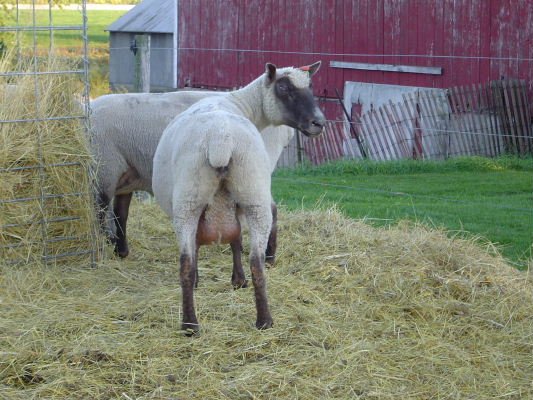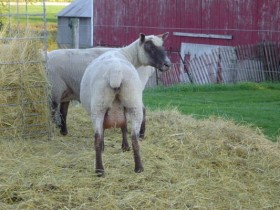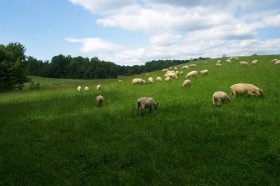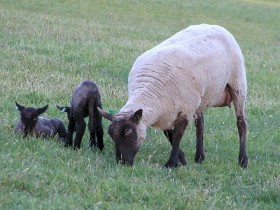
The Clun Forest – The Jersey of the Dairy Sheep
The Clun Forest – The Jersey of the Dairy Sheep by Mary Falk
When I was asked to write an article about Cluns in the dairy sheep industry, I thought that it would be quite a chore . . . the typical bunch of statistics, genetics, and industry gobbledygook that has inundated the dairy sheep industry for the past few years. Well, at the risk of sounding trite, I’m not going to bore you with all that. I’m just going to lay it on the line as to why my husband, Dave, and I swear by Cluns as the CORE BLOOD of our flock.
We’ve had sheep since ’89. Dave was raised on a dairy farm, and I raised sheep for miscellaneous 4-H projects as a kid and I milked dairy goats for our own use. We bought our original core flock from a farm in central Minnesota, a mixture of Finn, Dorset, and Romney. We added some 30 ewes of Dorset-Finn crosses, and together they formed our foundation flock.
Two years later, we heard about the Clun breed for the first time. We were intrigued by what was said about their hardiness and their ability to grow fast-gaining lambs on grass. Since we are an organic farmstead, we were particularly interested in what appeared to be their adaptability to various environments. We were trying to breed and select for a naturally parasite resistant sheep, so their breed characteristics seemed to be worth exploring. And that was the beginning of our love affair with the Clun.
We brought in a Clun ram, and that following spring we enjoyed the most robust lamb crop ever! I swear that those lambs hit the ground running! Everything that we had heard about the Cluns held true . . . easy birthing lambs, fast gaining, hardy and a bit skittish. But were they really skittish or perhaps just a bit smarter than the average sheep? When we began lambing out our Clun x ewes, we came to the conclusion that they were definitely more skittish and nervous than our Dorset x ewes.
When we decided to begin our sheep dairy in 1995, we didn’t know what to expect from the Cluns. We were told by Olivia Mills that they were milky, but tended towards being flighty and harder to train to the milking stand. We gave it a go and I do have to admit that a Clun has what seems to be a natural ability to fly. More than twice, a Clun sailed over Dave’s shoulder as she came up onto the platform for the first time.
We had trained 75 ewes in all . . . “cold turkey” on that first DAY FROM HELL, and I am still amazed that there weren’t any broken legs, theirs or ours. The Dorset x ewes did settle down more readily than the Clun ewes, but by the end of the first week, it seemed that once the Cluns realized that they were indeed going to survive this routine, they then couldn’t squat low enough for us! Their compliance was amazing! It seemed to us that the same wit about them that contributed to their spookiness was also responsible for their realization that “perhaps this could be fun.”
I apologize if I am being guilty of attributing people-like personality to these beasts . . . but you just have to see it to understand it. While all the other sheep got with the program and toed the line, the Cluns looked as though they were actually having fun. They were also the most curious about what was going on around them. We found them to be quite affectionate; they seemed to enjoy the attention the most! I would caution anyone against milking 100% Clun ewes; we have a few that we milk, and let’s just say they are an athletic challenge.
We initially started out milking with a cascading yoke system, but we found it to be too slow and restrictive. Dave then built a “squeeze” stand (all the sheep run onto the platform together with no head restraints and squeeze together), and we can now milk up to 27 ewes at a time, four ewes to a bucket. With two people milking, we can milk 130 sheep in about 75 minutes. The Clun personality seems to be better suited for this latter system than the yoke system.
The most important factor for our staying with the Clun as a dairy sheep is her ability to milk out high butterfat on grass. We began our season with them at a butterfat of 6.6% and ended with a 9%. Now I know that there is a school of thought out there claiming that it is the protein that makes the curd in cheese and that the butterfat isn’t all that important. It is true that you can make cheese from skim milk, but have you ever tasted it? People who are forking over the money for sheep milk cheeses are out for flavor period. Occasionally people may seek sheep cheese for health reasons, but they are few and far between.
The cheesemongers who are out for an excellent product don’t really care if it’s sheep milk or not: they want the unique taste. If I could give them the same unique taste that our Trade Lake Cedar Cheese has in a cow’s milk cheese, they would buy that just as readily. When Steven Jenkins, buyer for Fairway Markets in Manhattan, first tried our cheese, his immediate question was: “What breed of sheep are you milking? The flavor of this cheese just keeps going and going!” Need I say more?
The Clun has one of the highest butterfats, if not the highest, of any sheep. Butterfat carries depth of flavor and sweetness, the qualities that make sheep milk unique. And the Clun does this on grass. She is basically the Jersey cow of the dairy sheep industry. Our sheep are not heavy milkers: they average about 11/2 – 2 pounds per ewe per day. But it’s on grass only and they lactate around 135-150-day lactations. We’re happy with that.


